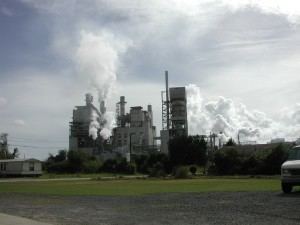 | ||
A paper mill is a factory devoted to making paper from vegetable fibres such as wood pulp, old rags and other ingredients. Prior to the invention and adoption of the Fourdrinier machine and other types of paper machine that use an endless belt, all paper in a paper mill was made by hand, one sheet at a time, by specialized laborers.
Contents
History
Historical investigations into the origin of the paper mill are complicated by differing definitions and loose terminology from modern authors: Many modern scholars use the term to refer indiscriminately to all kinds of mills, whether powered by humans, by animals or by water. Their propensity to refer to any ancient paper manufacturing centre as a "mill", without further specifying its exact power drive, has increased the difficulty of identifying the particularly efficient and historically important water-powered type.
Human and animal-powered mills
While the use of human and animal powered mills was known to Chinese and Muslim papermakers, evidence for water-powered paper mills is elusive in both of them. The general absence of the use of water-power in Muslim papermaking is suggested by the habit of Muslim authors to call a production center not a "mill", but a "paper manufactory".
Although scholars have identified "paper mills" in Abbasid-era Baghdad in 794–795, the evidence that waterpower was applied to papermaking at this time is a matter of scholarly debate. In the Moroccan city of Fez, Ibn Battuta speaks of "400 mill stones for paper". Since Ibn Battuta does not mention the use of water-power and such a number of water-mills would be grotesquely high, the passage is generally taken to refer to human or animal force.
Water-powered mills
An exhaustive survey of milling in Al-Andalus did not uncover a single water-powered paper mill, nor do the Spanish books of property distribution (Repartimientos) after the Christian reconquest refer to any. Arabic texts never use the term mill in connection with papermaking and the most thorough account of Muslim papermaking, the one by the Zirid Sultan Al-Muizz ibn Badis, describes the art purely in terms of a handcraft. Donald Hill has identified a possible reference to a water-powered paper mill in Samarkand, in the 11th-century work of the Persian scholar Abu Rayhan Biruni, but concludes that the passage is "too brief to enable us to say with certainty" that it refers to a water-powered paper mill. While this is seen by Halevi nonetheless as evidence of Samarkand first harnessing waterpower in the production of paper, he concedes that it is not known if waterpower was applied to papermaking elsewhere across the Islamic world at the time; Robert I. Burns remains altogether sceptical given the isolated occurrence of the reference and the prevalence of manual labour in Islamic papermaking elsewhere.
Hill notes that paper mills appear in early Christian Catalonian documentation from the 1150s, which may imply Islamic origins, but here too hard evidence is lacking, and the case for early Catalan water-powered paper mills has been thoroughly dismissed after a re-examination of the evidence cited by Burns. Likewise, the identification of early hydraulic stamping mills in medieval documents from Fabriano, Italy, is completely without substance.
The earliest certain evidence to a water-powered paper mill dates to 1282 in the Spanish Kingdom of Aragon. A decree by the Christian king Peter III addresses the establishment of a royal "molendinum", a proper hydraulic mill, in the paper manufacturing centre of Xàtiva. The crown innovation appears to be resented by the local Muslim papermakering community; the document guarantees the Muslim subjects the right to continue their way of traditional papermaking by beating the pulp manually and grants them the right to be exempted from work in the new mill.
The first permanent paper mill north of the Alps was established in Nuremberg by Ulman Stromer in 1390; it is later depicted in the lavishly illustrated Nuremberg Chronicle. From the mid-14th century onwards, European paper milling underwent a rapid improvement of many work processes.
The size of a paper mill prior to the use of industrial machines was described by counting the number of vats it had. Thus, a "one vat" paper mill had only one vatman, one coucher, and other laborers.
20th century
By the early 20th century, paper mills sprang up around New England and the rest of the world, due to the high demand for paper. At this time, there were many world leaders of the production of paper; one of such was the Brown Company in Berlin, New Hampshire run by William Wentworth Brown. During the year 1907, the Brown Company cut between 30 and 40 million acres of woodlands on their property, which extended from La Tuque, Quebec, Canada to West Palm, Florida.
“Log drives” were conducted on local rivers to send the logs to the mills. By the late 20th and early 21st-century, paper mills began to close and the log drives became a dying craft. Due to the addition of new machinery, many millworkers were laid off and many of the historic paper mills closed.
Characteristics
Paper mills can be fully integrated mills or nonintegrated mills. Integrated mills consist of a pulp mill and a paper mill on the same site. Such mills receive logs or wood chips and produce paper.
The modern paper mill uses large amounts of energy, water, and wood pulp in an efficient and complex series of processes, and control technology to produce a sheet of paper that can be used in diverse ways. Modern paper machines can be 500 feet (150 m) in length, produce a sheet 400 inches (10 m) wide, and operate at speeds of more than 60 miles per hour (97 km/h). The two main suppliers of paper machines are Metso and Voith.
